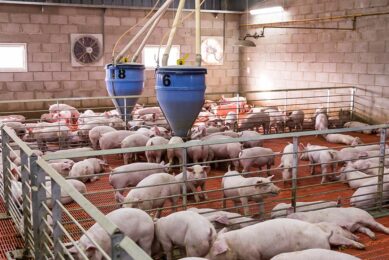Milk Immunoglobulins
We all know quite well that sow’s milk is an ideal source of nutrients for newborn piglets. Not only milk, and especially colostrum, is rich in nutrients like protein, lipids, and lactose, but these very nutrients are extremely digestible. What is less known is the fact that sow’s milk and colostrum are also an essential source of functional compounds, mostly proteins that play an important role in piglet growth, development, and overall health.
Very recently, a team of researchers from China* and the USA investigated the expression of such functional proteins in sow’s milk and colostrum in relationship to mammary gland position. This study was done to better understand why piglets on anterior and middle mammary glands grow faster than piglets obtaining milk from posterior mammary glands.
©
Although a number of theories exist to explain this phenomenon, none has provided a complete picture so far, perhaps because it is a combination of factors leading to it. In the above study, just published in the Journal of Animal Science (2010, 80:2657-2664), it was demonstrated that milk and colostrum from the anterior (and to a lesser degree middle) glands were richer in functional proteins such as immunoglobulins, lactoferrin, lactadherin, and haptaglobin than milk and colostrum obtained from posterior glands.
©
It is important here to mention that all of the above compounds contribute significantly to piglet passive immunity and gastrointestinal health and integrity. This clearly supports the notion that piglets receive and require more than just nutrients to live and thrive. It also supports the favourable results obtained in other trials where piglets were supplemented with such functional proteins as immunoglobulins and lactoferrin. Although the latter is currently commercially unavailable, immunoglobulins are used quite extensively through animal plasma and hyper-immunized egg powder.
©
To this end, we could question the adequacy of simple diets for young pigs, especially after weaning, when milk supply is abruptly terminated. Most such formulas contain all required nutrients, such as protein, carbohydrates, lipids, minerals, and vitamins, but they are rather deficient in functional proteins. Only the presence of milk products provides a rather weak supply of such components, but in low-quality diets, milk products are used sparingly. If we account for the rather poor (cheap) quality of such milk products (quite often over-heated), then we can discount the presence of functional proteins (heatsensitive) altogether!
©
Perhaps, the presence of immunoglobulins in high quality diets (through high levels of whey, plasma, and egg immunoglobulins) can explain the better performance and higher health supported by such diets. Of course, we still don’t know how much is required of this ‘novel nutrient’, but immunoglobulins are today recognised as almost essential in piglet nutrition, although most recognise as such their sources. This is of course the case with animal plasma, where considerable confusion exists.
©
In conclusion, I believe there is increasing evidence supporting the need for accounting for functional compounds in milk when formulating piglet diets. In my opinion, the most important functional protein is the group of immunoglobulins. Thus, when you next find yourself buying a piglet diet you may want to ask your supplier about the type, quality, and source of the immunoglobulins used!
©
* Many thanks to Dr. J.J. Wang from China Agricultural University (Beijing).
©
Join 18,000+ subscribers
Subscribe to our newsletter to stay updated about all the need-to-know content in the pigsector, three times a week. Beheer
Beheer










 WP Admin
WP Admin  Bewerk bericht
Bewerk bericht